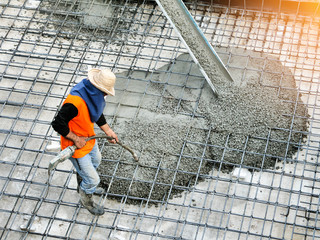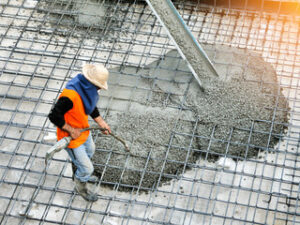
What Does a Concrete Contractor Do?
Concrete Contractors install new and repair existing concrete structures. The industry includes the forming, pouring, and finishing of concrete footings, foundations, slabs, basements, private driveways and parking areas, and retaining walls.
A strong work ethic is a requirement for this job. It helps to have experience in the construction industry and familiarity with common safety standards. Visit https://concretecontractorcoloradosprings.com/ for more information.
Site preparation is a crucial first step in the construction process. It involves clearing the land and removing any debris. It also includes grading and excavating the land for construction. This allows the crew to start work with a solid foundation. The building could suffer from long-term damage and costly repairs without a good foundation.
Site Preparation can be done manually or by using heavy equipment such as tractors and excavators. Choosing a crew that is experienced and qualified to handle these tasks is important. Having an inexperienced crew can cause delays in the project, which can cause more costs and lead to poor results. This is why it’s best to hire a company that specializes in site preparation.
A skilled crew will be able to clear the site quickly and efficiently. This will allow the rest of the construction to progress smoothly and on schedule. It will also ensure that the job is completed safely and on budget.
One of the most important aspects of site preparation is testing the soil. Different types of soil have different bearing capacities, and it’s essential to know if the soil can support the structure being built. Soil tests can also reveal any potential problems with the ground, such as if it’s too soft or if it contains toxic chemicals.
Another part of site preparation is installing utilities, such as water, gas, and electricity. This can be difficult to do on a construction site, but it’s necessary for the building to be functional. It’s also a good idea to put in sewage and drainage systems before beginning construction. This will help to prevent water infiltration, which can damage a building’s foundation and cause structural problems.
Site preparation can also involve constructing access roads for workers and machinery during the construction process. This helps keep the site clean and safe and reduces the impact on nearby properties. It can also help prevent erosion and runoff by directing rainwater away from the building site. It’s also important to use anti-termite treatment to protect the building from termites, which can destroy it.
Formwork
Concrete Contractors use formwork to build temporary molds in which fresh concrete is poured to construct designated structural concrete elements and achieve their shape. Formwork can be made of a variety of materials including timber, plywood, steel and fiberglass. The type of formwork used on a project can vary depending on the needs of that project and the preferences of the Concrete Contractor. The design of the formwork should be based on a combination of technical standards and engineering principles to produce a functional and safe formwork system.
For example, the rate at which concrete is poured should be carefully calculated to ensure that the concrete has enough time to set. Contractors gauge the strength of the concrete by measuring its slump, a measurement that reflects how much water is in the mix. A high slump means a stronger concrete, while a low slump indicates that the concrete is weak.
Formwork is also designed to withstand any dead (e.g., weight of the concrete structure and other permanent loads) and live (e.g., weight of building occupants, vehicle traffic and equipment) loads. It should be rigid and support itself correctly with props or braces to ensure that it does not deform under stress. Ideally, formwork should be designed so that various components can be removed in a desired sequence without damaging the concrete it forms.
Some formwork is erected on site with a crane and other hardware like ties, wedges, clamps and braces that workers assemble by hand. Other times, prefabricated forms that are designed and built in a factory can be shipped to a construction site and hoisted into place with a crane. These larger systems are often designed to withstand higher pressures of fresh concrete, so they are typically used for large commercial projects like skyscrapers and extensive infrastructure projects.
Regardless of how the formwork is erected, it should be inspected by a qualified person to verify that it meets the design requirements before use. For safety reasons, it should be fenced off to prevent other trades from accessing the area underneath until the concrete has achieved sufficient strength. Concrete contractors should communicate with other trades on the project to keep them updated about when the formwork is ready.
Pouring
Concrete is one of the strongest building materials, but like any material it needs to be handled with care during construction. Sloppy work can lead to premature deterioration, safety hazards for the occupants of the building and even structural failure. In addition to the right mix, the proper pouring of concrete takes special skill to achieve a high level of quality.
The first step is to clear the area of grass, rocks and other debris. This helps reduce the risk of heaving from expansive soils and frost. Earth moving equipment can speed up this process, especially for larger projects.
After the formwork is set up and ready, the concrete can be poured. This is usually done using a concrete truck equipped with multiple chutes, which can reach up to fifteen feet in length. This method is called tailgating and it is a lot faster than filling concrete into the forms by hand with wheelbarrows. Concrete buggies, which are motorized vehicles that carry the concrete, can also be used for large pours.
During the pouring stage, it is important to control the slump of the concrete and keep the aggregates positioned evenly throughout the mixture. It is also vital to limit the water content of the concrete and not oversaturate it. This will help prevent concrete segregation and bleed. It is also important to avoid letting concrete drip from the sides of the form or onto the floor, which can cause problems with finishing.
Once the concrete has been poured, it must be allowed to cure for a minimum of 28 days to achieve full strength. During this time, the contractor should test for strength gains every seven days. This can help them determine whether or not the concrete has reached a sufficient compressive strength for formwork removal. The use of an accelerator can speed up the curing process, allowing the concrete to be poured sooner.
Another way to ensure the proper pouring of concrete is to use an experienced concrete contractor. The right concrete contractors can prepare the site, set up the correct formwork, provide accurate estimating and scheduling and ensure that the concrete is poured correctly. This will result in a strong, long-lasting structure that is safe for its occupants.
Finishing
Once the concrete has been poured and the forms have been removed it’s time for the finishing process. This is the stage in which the concrete contractor creates a surface of a desired texture, hardness and appearance, which can either be functional or decorative. It’s important that the finishing concrete contractors take their time during this process, since the concrete is still wet and hasn’t reached its full strength yet.
First, the concrete is screeded to remove any excess concrete and bring it to a level surface. This can be done using a 2×4 or a special tool called a screed board. This is one of the most crucial steps in the finishing process if a truly even surface is to be achieved.
Next, the concrete is floated to remove any ridges that may have been left from the screeding process. This can be done by hand or using a bull float, which is a long-handled tool with flat ends rather than rounded ones. It is also possible to use power floats in this phase of the finishing process.
At this point, the concrete is ready to be troweled if required for its end use. The concrete must be damp for this to be done correctly and it is important that the concrete contractor knows how much water to add for each pass. If the concrete is troweled too early, it will develop dark “trowel burns” and if it is troweled too hard, it will produce an undesirable chatter texture.
The finishing concrete contractor can then apply a sealer to protect the surface and prevent stains. They can also use a grinder to smooth the concrete, giving it a finish that ranges from matte to shiny. In order to get the best results, it is important that the concrete contractor takes their time and uses a high-quality diamond grit.
During the finishing process, it’s important that the concrete contractors keep the general contractors and the on-site superintendent updated about the progress of their work. This will help everyone stay on track with the project schedule as well as ensure that the final product is delivered according to expectations. Having the right tools for the job is also essential.

